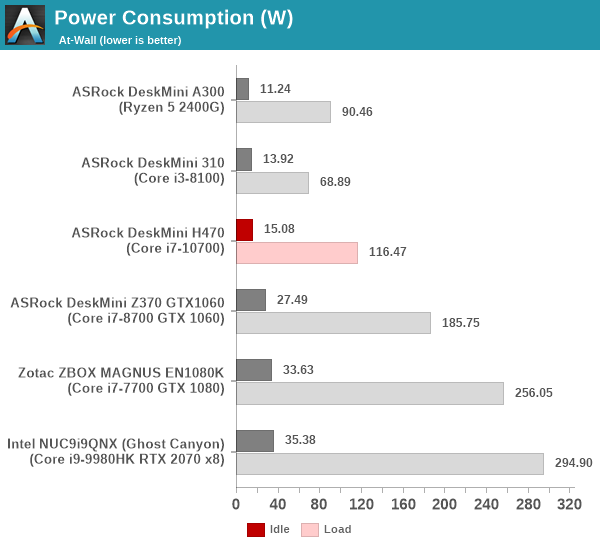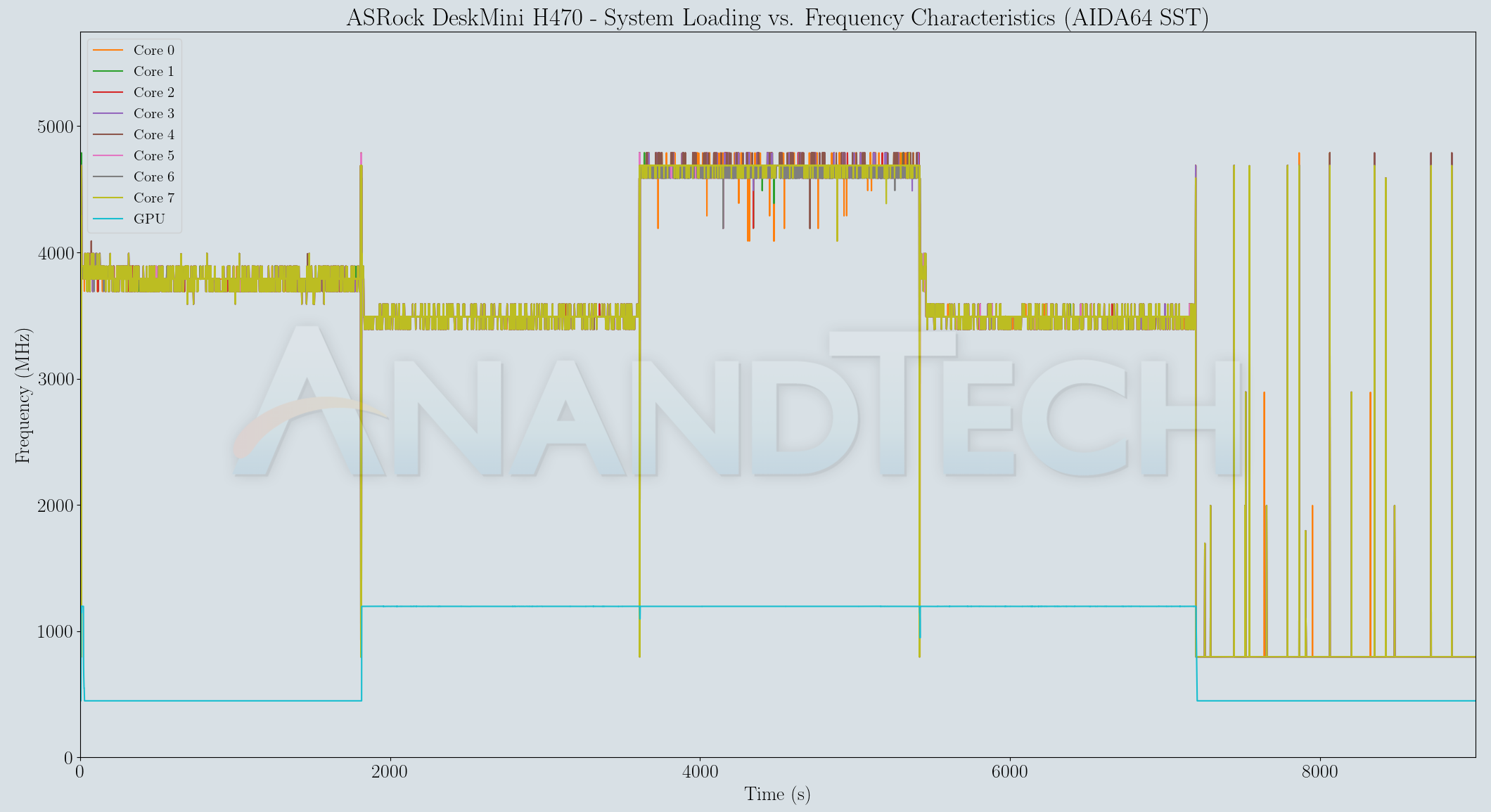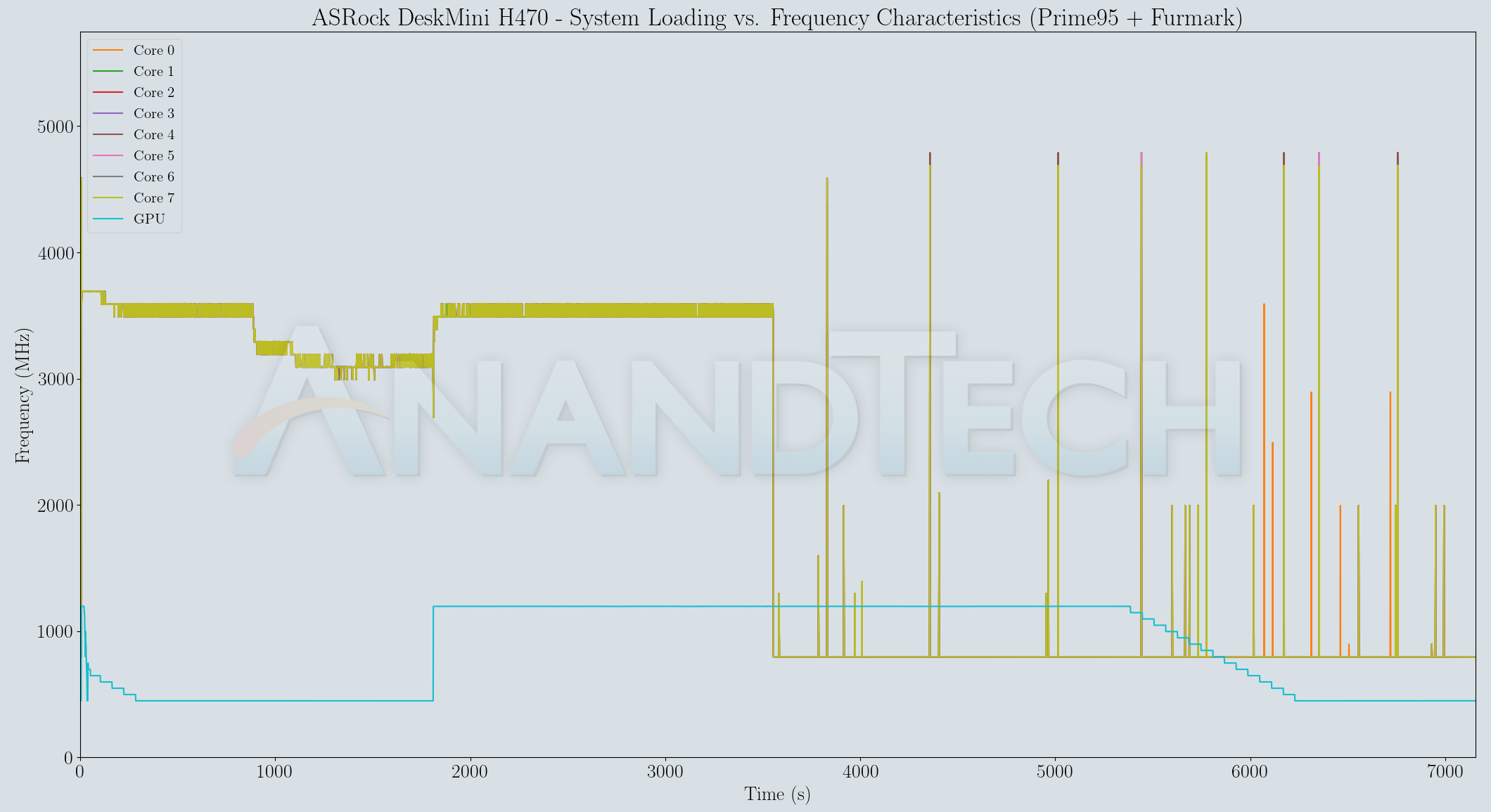ASRock DeskMini H470 Review: A No-Frills LGA 1200 mini-PC Platform
by Ganesh T S on December 29, 2020 8:00 AM ESTPower Consumption and Thermal Performance
The power consumption at the wall was measured with a 4K display being driven through the DisplayPort port in non-HDR mode. In the graphs below, we compare the idle and load power of the ASRock DeskMini H470 with other low power PCs evaluated before. For load power consumption, we ran the AIDA64 System Stability Test with various stress components, followed by our custom stress test (Prime95 and Furmark) and noted the maximum power consumption at the wall.

The idle power consumption can be classified into two sets - systems equipped with discrete GPUs idle at 25W+, while ones without idle aroud 10W+ lesser. Compared to other dGPU-less systems, the DeskMini H470 leads the idle numbers at 15W. On the load side too, we see it at the top of the charts in its class thanks to Intel's efforts to get as much performance as possible with suitable PL1 and PL2 numbers for its Comet Lake-S processors as the system design might allow.
Our thermal stress routine starts with the system at idle, followed by four stages of different system loading profiles using the AIDA64 System Stability Test (each of 30 minutes duration). In the first stage, we stress the CPU, caches and RAM. In the second stage, we add the GPU to the above list. In the third stage, we stress the GPU standalone. In the final stage, we stress all the system components (including the disks). Beyond this, we leave the unit idle in order to determine how quickly the various temperatures in the system can come back to normal idling range. The various clocks, temperatures and power consumption numbers for the system during the above routine are presented in the graphs below.
| ASRock DeskMini H470 System Loading with the AIDA64 System Stability Test | |||

The system has no trouble keeping the package power at 65W - this is what the processor is rated for, and the DeskMini H470 configuration allows exactly that. Core clocks stay well above the rated 2.9 GHz for the most part and the GPU clock is steady during the course of the stress segments where the GPU is active. The Silverstone SST-AR11 heat-sink does wonders - the package temperature never crosses 65C! However, the absence of airflow to other components is an issue - the voltage regulators touch 100C and one of the SSD temperature sensors goes as high as 80C when the SSD is stressed.
| ASRock DeskMini H470 System Loading with Prime95 and Furmark | |||

In the custom stress test involving Prime95 and Furmark, the package power consumption stays at 65W for scenarios involving the CPU. However, when the GPU alone is stressed, the number falls down to a sub-30W value. This is not due to any thermal limitations, but just the nature of the iGPU in the Core i7-10700. The GPU clock stays at the rated 1200 MHz during the full GPU-loading segment. Core clocks are also above 2.9 GHz in the first two segments. The reason for the variation / push down of the core clocks around halfway through the Prime95-only scenario is because of the temperature of the voltage regulation circuit. It shoots up as high as 105C even when the cores themselves are at 60C only.
The DeskMini H470 configuration tested above has no problems with thermal limits on the processors thanks to the excellent performance of the Silverstone SST-AR11 heat-sink. However, the case design has limited airflow as there is no other fan to cool down the SSD and/or voltage regulating circuitry. Any performance limitations are due to the thermals associated with the VRMs. While the installed CPU can do work corresponding to its rated power consumption numbers / TDP, there may be limitations on trying to extract the last bit of performance from the processor - an aspect that ASRock tries hard to deliver with features such as the 'base frequency boost' in the 'OC Tweaker' BIOS section.










26 Comments
View All Comments
jeremyshaw - Tuesday, December 29, 2020 - link
I had the FT03 mini as well. There really isn't much of a way to cool the CPU in that chassis. Same with the GPU. It's a slightly worse SG05 with less venting (I guess a token sliver of vents was added above the IO plate). Why they didn't use the fullsize FT03 layout to preserve some semblance of CPU heatsink clearance? Who knows. Maybe they had the SG05 tooling on hand already.Coming from a FT03 fullsize (which I have a litany of grievances with, even though I liked the case overall), the mini just missed the mark for me.
Samus - Wednesday, December 30, 2020 - link
I agree with your sentiments. And I still question my sanity for living with it but I really do love it. It's beautiful. The key to making it work is obviously using a GPU with a blower, which is now virtually impossible to find as even nVidia has abandoned the Titan-class vapor chamber coolers. Every bit of excess heat needs to be exhausted from this case and a GPU blower actually HELPS cool the rest of the case while gaming.Danvelopment - Friday, January 1, 2021 - link
"14nm (optimized)"[chuckles in an optimised fashion]
Danvelopment - Friday, January 1, 2021 - link
They better be making HUGE dies to still be stringing that one out. Die sizes shrunk dramatically after Intel's last leap with Sandy Bridge because $$$.Quango - Wednesday, January 27, 2021 - link
Asrock has released a BIOS 2.0 for the Deskmini H470 with "Support 11th Gen processors".The second M.2 slot on the backside now appears in the BIOS settings and in HWInfo, but I don't know yet if it is functional with Comet Lake.
flee2021 - Thursday, February 4, 2021 - link
Intel 400 series chipset M.2 slots connect to the PCH and not the CPU. So the second M.2 slot should work without problems. I am looking forward to seeing what the Intel 11th Gen Core processors' CPU PCIe 4.0 x4 slots can do for the M.2 slot when the 500 series motherboards are available.